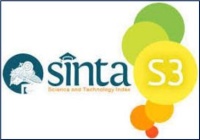Identifikasi Pakan Lebah Madu Endemik Sulawesi Apis nigrocincta (Smith, 1861)
Abstract
Keywords
Full Text:
PDFReferences
Adiwena, M., Nurjannah, N., Pandiangan, G. V., & Andi, A. (2024). Pembuatan Hotel Lebah Kelulut (Trigona sp.), Komoditas Unggulan Green Economy: Kelulut Hotel (Trigona sp.), Green Economy Leading Commodity. PengabdianMu: Jurnal Ilmiah Pengabdian kepada Masyarakat, 9(5), 829-838. https://doi.org/10.33084/pengabdianmu.v9i5.6594
Ahsani, F. A., Bintoro, A., Asmarahman, C., & Duryat, D. (2023). Identifikasi Jenis Tumbuhan Sumber Pakan Lebah Madu (Apis cerana) Di Kebun Lebah Desa Buana Sakti, Kecamatan Batang Hari, Lampung Timur. Journal Of People, Forest And Environment, 3(2), 11-20. http://dx.doi.org/10.23960/jopfe.v3i2.7515
Algifari, A. (2024). Inventarisasi Jenis-Jenis Tanaman Penghasil Nektar Dan Polen Sebagai Pakan Lebah Madu Trigona Di Desa Bengkaung Kabupaten Lombok Barat. i-SAPI Journal: Integrated and Sustainable Animal Production Innovation, 1(1), 25-35. https://doi.org/10.29303/i-sapi.v1i1.4982
De Lima, D., Lamerkabel, J. S. A., & Welerubun, I. (2020). Inventarisasi Jenis-Jenis Tanaman Penghasil Nektar Dan Polen Sebagai Pakan Lebah Madu Apis mellifera Di Kecamatan Kairatu Kabupaten Seram Bagian Barat. Agrinimal Jurnal Ilmu Ternak dan Tanaman, 7(2): 77–82. https://doi.org/10.30598/ajitt.2019.7.2.77-82
Ferdyan, R., Sumarmin, R., & Putri, D. H. (2021). Perbandingan Sumber Pakan Dan Strategi Pemberian Pakan Apis cerana dengan Apidae Lainnya: A review. Bio-Lectura: Jurnal Pendidikan Biologi, 8(1): 37-44. https://doi.org/10.31849/bl.v8i1.6484
Gusmalawati, D., Huda, M. F., Fauziah, S. M., Banyo, Y. E., & Abidin, Z. (2021). Karakterisasi Morfologi Polen Dari Sepuluh Jenis Tumbuhan Dari Famili Yang Berbeda. G-Tech Jurnal Teknologi dan Terapan, 4(2): 303-308.
https://www.academia.edu/download/89606811/612.pdf
Kusmoro, J., Febrian, R. R., Shanida, S., Husodo, T., Mutaqin, A. Z., & Hermawan, W. (2024). Identifikasi Polen sebagai Indikator Keanekaragaman Tumbuhan Sumber Pakan Lebah Madu (Apis cerana F.) di Kawasan Konservasi Hutan Kota di Kabupaten Bandung, Jawa Barat. Agrikultura, 35(1), 103-111.
https://jurnal.unpad.ac.id/agrikultura/article/view/42694
Manusawai, J., & Pakpahan, E. S. (2024). Kondisi Habitat dan Kualitas Madu Lebah Tanpa Sengat Kampung Rimba Jaya Kabupaten Biak Numfor: Kondisi Habitat dan Kualitas Madu Lebah Tanpa Sengat Kampung Rimba Jaya Kabupaten Biak Numfor. Median: Jurnal Ilmu Ilmu Eksakta, 16(2), 96-111.
https://doi.org/10.33506/md.v16i2.3486
Mooy, B. Z. (2020). Identifikasi Faktor-Faktor Yang Mempengaruhi Dinamika Produksi Madu Lebah Hutan (Apis dorsata) di KDHTK Diklat Sisimeni Sanam, Kabupaten Kupang. Jurnal Widyaiswara Indonesia, 1(4): 171-186.
http://ejournal.iwi.or.id/ojs/index.php/iwi/article/view/51
Priambudi, A. S., Raffiudin, R., & Djuita, N. R. (2021). Identifikasi Tumbuhan Sumber Polen pada Madu Lebah Heterotrigona itama dan Tetragonula laeviceps di Belitung Identification of Plants as Pollen Source in Honey of Stingless Bee Heterotrigona itama and Tetragonula laeviceps from Belitung. Jurnal Sumberdaya Hayati, 7(1): 25–35.
https://www.academia.edu/download/98812470/22024.pdf
Rahmad, B., Damiri, N., & Mulawarman, M. (2021). Jenis Lebah Madu Dan Tanaman Sumber Pakan Pada Budi Daya Lebah Madu Di Hutan Produksi Subanjeriji, Kabupaten Muara Enim, Sumatera Selatan (Honeybee Diversity and Woof Source of Beekeeping in Subanjeriji Production Forest, Muara Enim District, South Sumatera). Jurnal Penelitian Kehutanan Faloak, 5(1), 47-61.
https://pdfs.semanticscholar.org/94f9/3652589a6fb1a1985ee801f3e0ec731c7668.pdf
Sari, M. A., Zural, M. M., & Jasmi, J. J. (2020). Jenis-Jenis Tumbuhan Sebagai Sumber Pakan Lebah Madu Apis cerana Fabr. dan Apis dorsata Fabr. Serta Sumbangsihnya Untuk Materi Plantae SMA/MA. Jurnal Bioconcetta, 5(2): 59–68.
https://scholar.archive.org/work/aryifbjpjjezre2h47mc27sae4/access/wayback/https://ejournal.upgrisba.ac.id/index.php/BioCONCETTA/article/download/3662/pdf_1
Shullia, N. I., Subchan, W., Raffiudin, R., Atmowidi, T., Priawandiputra, W., Ariani, N. S., & Novidayanti, A. A. (2024). Temporal resource partitioning of the flight activities of three bee species in East Java: Pembagian sumber daya temporal dari aktivitas terbang tiga spesies lebah di Jawa Timur. Jurnal Entomologi Indonesia, 21(3), 234-246. https://doi.org/10.5994/jei.21.3.234
Syifa, K., Haneda, N. F., & Rachmawati, E. (2023). Keanekaragaman Pakan Lebah Madu Apis cerana di Hutan Rakyat Berdasarkan Karakteristik Polen (Diversity of Apis cerana Honey Bee Foraging Plants in Community Forests Based on Pollen Characteristics). Jurnal Penelitian Hutan Tanaman, 20(1): 51-62.
https://doi.org/10.59465/jpht.v20i1.311
Tahir, H., Irundu, D., & Rusmidin, R. (2021). Jenis Tumbuhan Sumber Pakan Lebah (Trigona Sp.) Di Desa Mirring Polewali Mandar Sulawesi Barat. Jurnal Nusa Sylva, 21(2): 39-47. https://doi.org/10.31938/jns.v21i2.339
DOI: https://doi.org/10.33394/bioscientist.v13i1.15190
Refbacks
- There are currently no refbacks.

This work is licensed under a Creative Commons Attribution-ShareAlike 4.0 International License.

Bioscientist : Jurnal Ilmiah Biologi is licensed under a Creative Commons Attribution-ShareAlike 4.0 International License
Editorial Address: Pemuda Street No. 59A, Catur Building Floor I, Mataram City, West Nusa Tenggara Province, Indonesia











